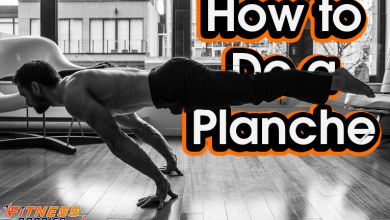Is Jumping on A Trampoline a Good Exercise?
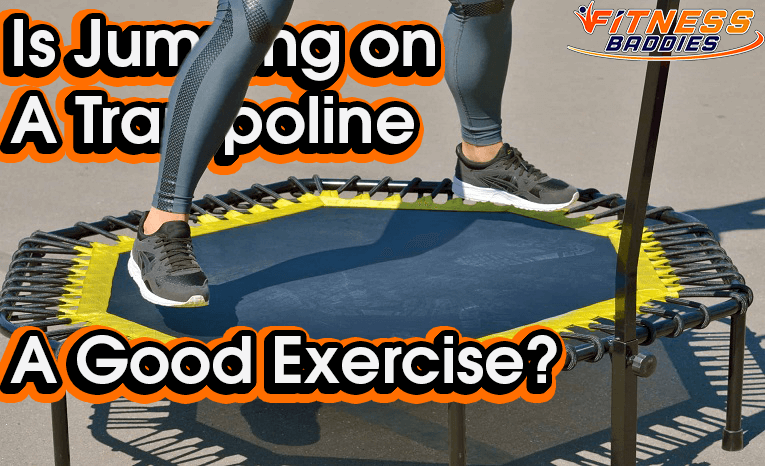
As kids, we spent a lot of time on the largish trampoline in our backyards. We were obsessed with the thing, sometimes jumping for hours at end like our lives depended on it.
It was pure fun though. Not really motivated by the many health benefits that it offers. It was years later that I realized that it is also a great cardiovascular workout, and it qualifies as an effective addition to any essential core exercises regimen.
But we don't really see many adults jumping around on a trampoline (sadly). There are a lot of misconceptions that surround it too. Some people think that it's dangerous, which while not entirely untrue, is a binary statement that generalizes a lot of things.
Nevertheless, if you were unsure whether jumping on a trampoline is worth the effort, then you are at the right place. I have used trampolines all my life and still I use it even now at the age of 33 when I want to get in a dose of cardio after my workouts.
I will share some tips, tricks and my personal experiences with the trampoline today. Stay tuned.
Is Jumping on a Trampoline a Good Exercise?
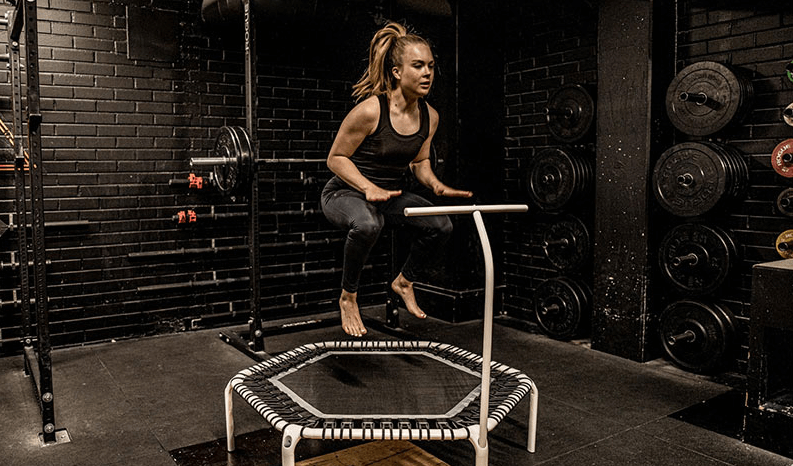
First things first, jumping on a trampoline is an excellent exercise. It's a full body compound movement somewhat similar to box jumps in Plyometrics.
You generate an explosive bout of power and strength from your lower body.
Then you brace your core for the entire duration of time that you are jumping on the trampoline.
It involves some major muscle groups like the quads, hamstrings, glutes, calves, hip flexors, adductors and the core.
However, it demands a certain level of experience, mobility and overall fitness to pull off without getting injured.
Let's say, it's not like running for hours on a treadmill or hopping on a stationary bike or elliptical. You need to have some amount of knowhow of how to use it.
Is Jumping on A Trampoline a Full Body Workout?
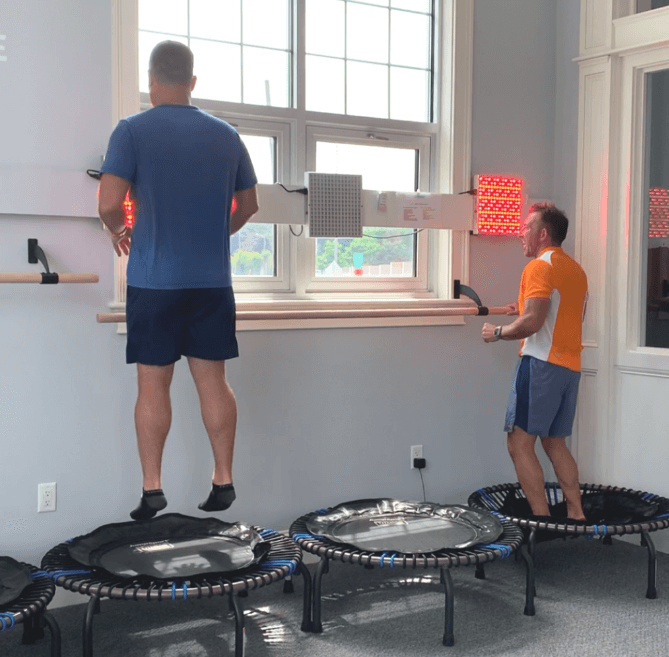
Yes, it is. Jumping on a trampoline involves almost all muscles of the lower body as well as most in the upper body.
You engage the shoulders, neck, abdominal muscles, back, hip flexor muscles, and all the muscles of the lower body that we shared earlier. It might seem easy, but if you're taking it as a serious workout, it takes energy. So yes, before jumping in, boost your energy reserves with a good natural pre workout, you know, one that is beta alanine-free. Something like this 4-gauge preworkout.
Research suggests that the rebound effect is also great for your pelvic floor muscles.
It is also a tremendous cardiovascular workout when done right. So, you are engaging your lungs and forcing your heart to work faster.
Last but not the least, it’s a major endorphin booster.
There are some studies that suggest that a 20-minute trampoline workout might be physiologically better than a 20-minute run at 10km/hour.
How Does Jumping on A Trampoline Work?
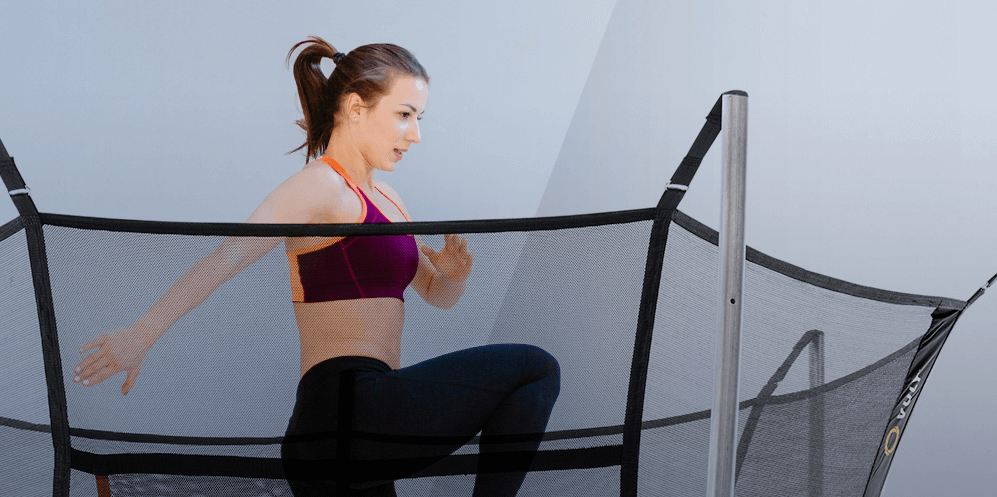
Jumping on a trampoline in principle, is really simple. You find a trampoline and start to bounce on it. But, you need to remember that you are not a spring chicken anymore, nor are you bouncing on a trampoline for fun in your backyard.
This is fitness and you are an adult, and yes, it also ranks as one of those cool but effective exercises for teenage girls looking to get fit. These are two big changes which eliminate the margin for error. Get it wrong and you'll probably end up injured and hate trampolines for the rest of your life.
Get it right, and it will be the best workout you got in a long time.
How to Jump Higher on A Trampoline
I am going to share a few tips with you which will make your trampoline time more productive and injury free.
Jump on The Trampoline and Not Into the Sky

One of the commonest misconceptions that surround the trampoline is that you hop on it and you try to jump up. That's what we did as kids. It sure was fun trying to jump higher than your buddy.
But, jumping on the trampoline is not solely about how high you can jump. It's about balance, coordination and thwarting injuries while still getting an amazing workout.
For that, you need to jump on the trampoline not in the sky. That means, you need to engage your core and engage your quads while landing on the trampoline. Stay low and jump into it.
Power Off the Heels
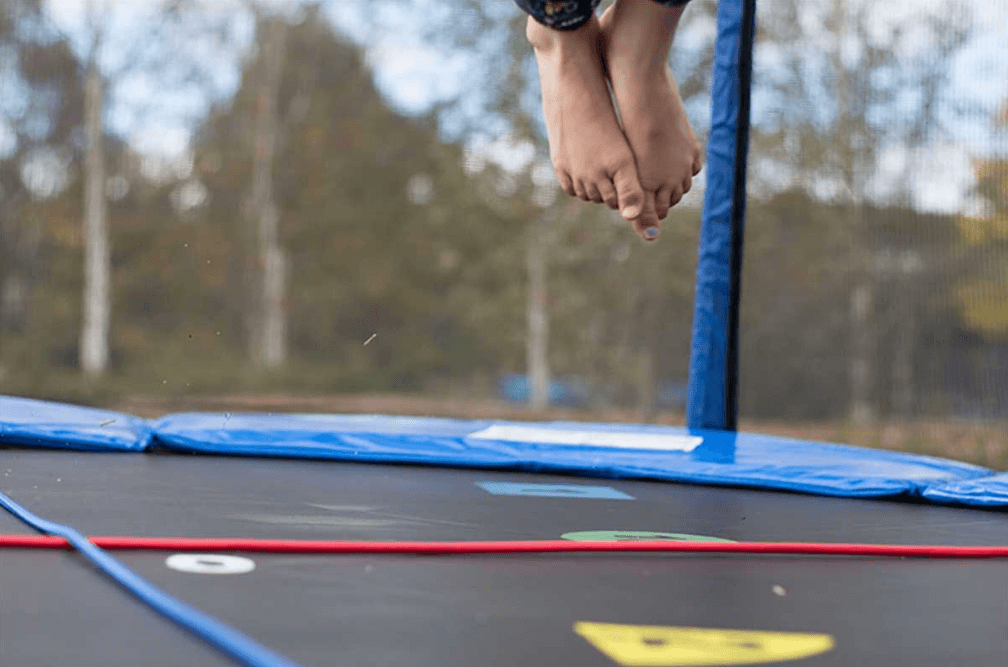
We are conditioned to use our toes to soften our landings whenever we jump. It's universal and it reduces the impact on our ankles and knees.
But, when you jump on a trampoline, use your heels to land and bounce off it. This way, you make the trampoline do most of the work for you and also stretch your hamstring muscles through the landing.
Keep practicing this until it becomes second nature because it’s going to make all the difference between you getting injured and performing at your best.
Keep the Hip Flexors Free
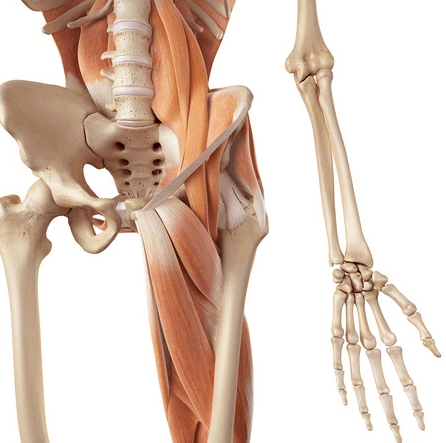
If this is the first few times you are using a trampoline, you are bound to be a little nervous. After all, you don't want to end up on the 'Epic Trampoline Fails' video on YouTube.
But, you shouldn't grip your lower body muscles too hard or keep it too tensed. It will only limit mobility and again, shift the forces in places that you do not want it to. Instead, keep your hips and hip flexors relaxed.
Now, if your hip mobility and stability is wanting, then you need to focus on loosening them up with the right number of lunges, or doing several squats everyday, or other similar workouts that help work this area. You will need this flexibility for other workouts as well besides trampoline jumps.
Maintain a neutral pelvis through the entire thing and keep your upper body free.
Knees to The Chest
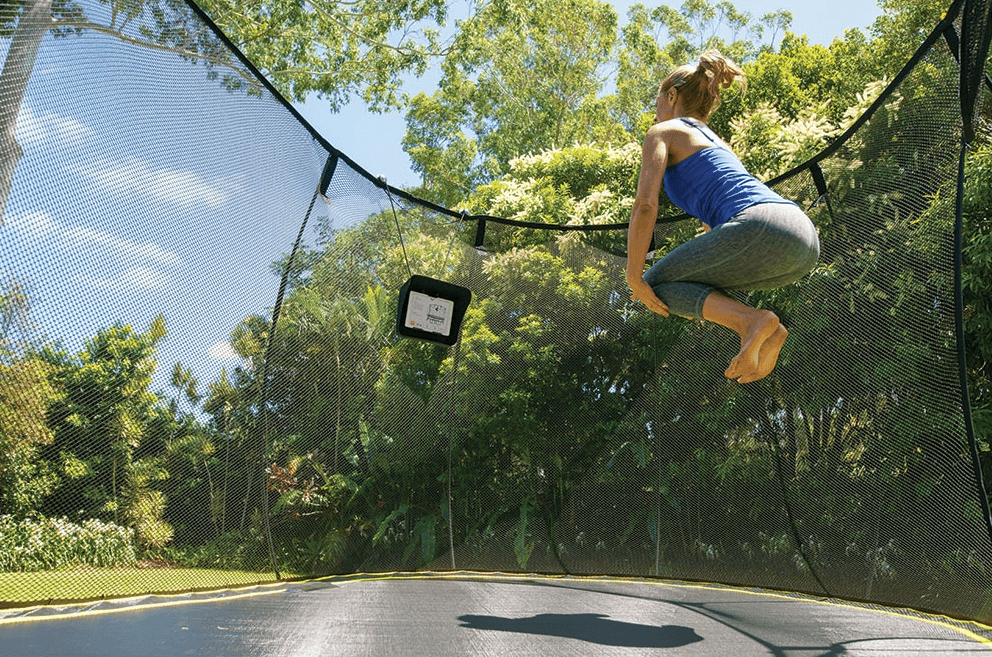
It might seem like common sense, but you'd be surprised by how many people jump on a trampoline and keep their knees straight, rather than bending them.
You should always jump like you are trying to squat. The knees should be bent and relaxed when you land. When you jump up, bring the knees to the chest and brace your lower abs. This should help you get rid of belly fat in the long run, too.
Do not bend forward or hinge too much at the hip because there's a risk that you may be caught off balance and tip over.
Time the jumps right
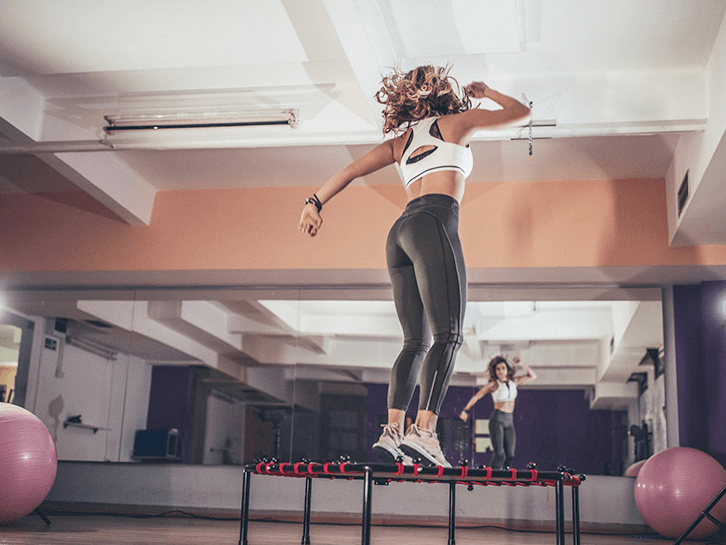
Trampolining is all about timing the jumps right. Let gravity take care of most of the work for you and let your feet touch down softly on the trampoline before springing up again.
It might take a little practice before you are able to pull off mind boggling jumps. So give it time.
Is Jumping on A Trampoline Good for Weight Loss?
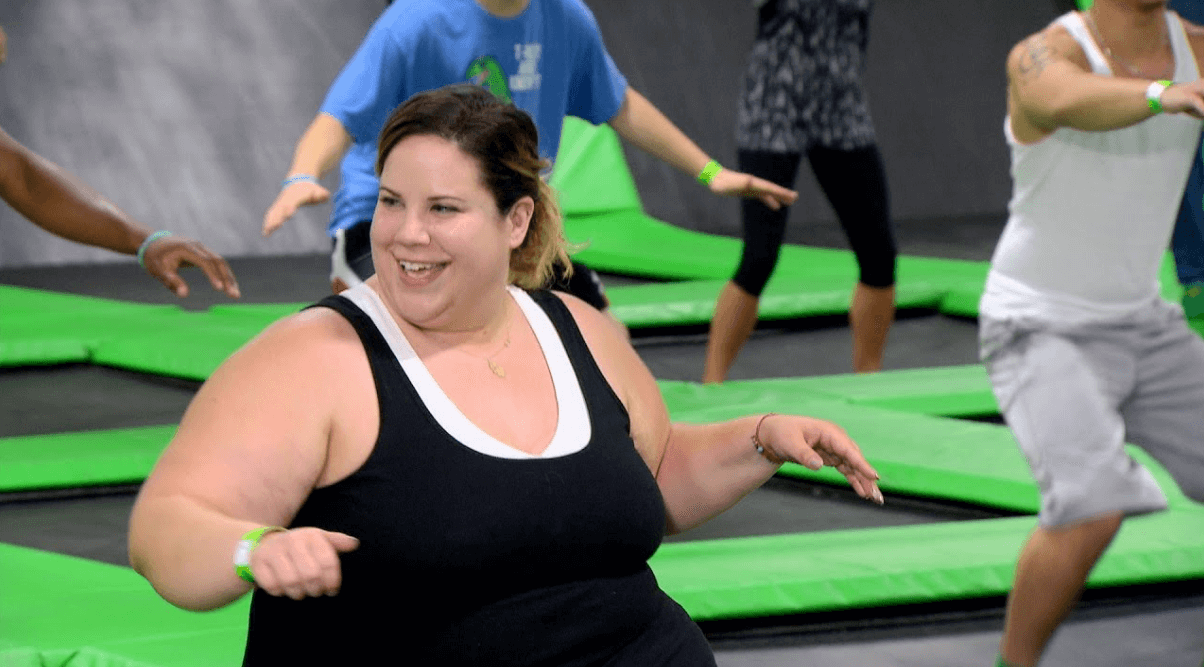
Over the years, trampolining has undergone a revival of sorts, especially since the rebounder trampoline became a big hit.
Researchers have been trying to see if trampolining can be included in fitness regimes to reduce weight and improve cardiovascular health, especially since it is reasonably low impact when done right.
So far, the results are mixed. But there is mounting evidence that it might be as effective or even more effective than common forms of cardiovascular exercise.
- In 2016, Time published an article(1) that spoke about research that shows how rebounding produces the same physical benefits that a 6 miles per hour run or biking exercise produces.
- A 2018 study on the mini trampoline(2) reports that it can produce significant benefits by reducing fat mass, improving muscle mass, as well as reducing high blood pressure, diabetes as well as lipids.
- A study conducted by NASA in 1980(3) shows that jumping on the trampoline produces greater biomechanical stimuli than running does.
While there are not many studies that show the weight loss potential that trampolines have, all of them are positive about how it aids in strengthening the muscles, bones and tendons. Besides, exercise in general increases metabolism and thus aiding in weight loss.
Muscles Worked by Jumping on A Trampoline
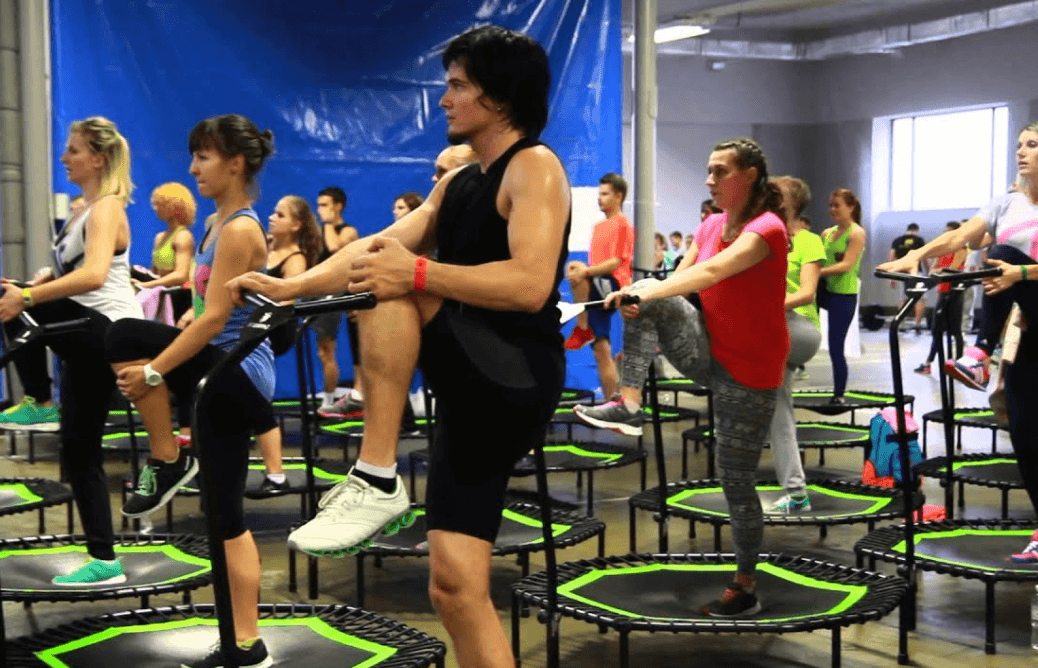
The trampoline is a full body exercise tool that involves almost 400 muscles at a time. I will touch on the primary ones, especially the ones that I have managed to tone and shape.
Core
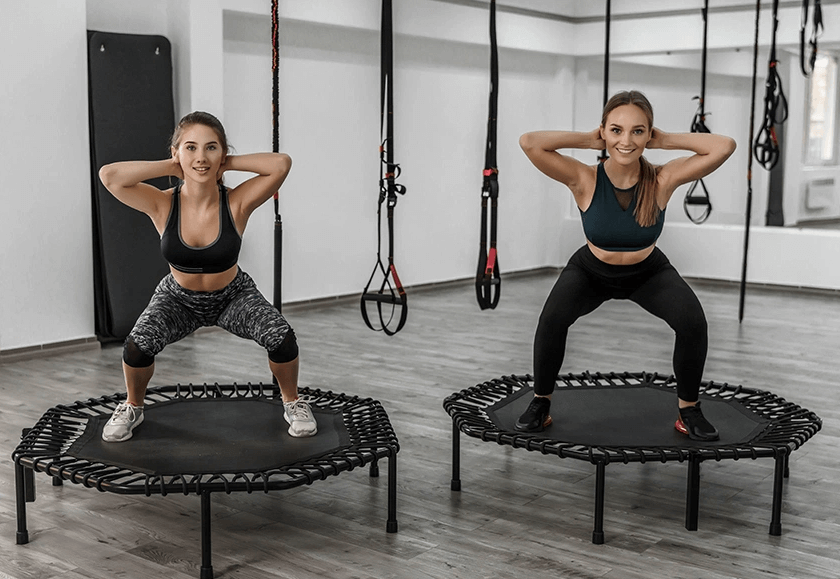
Core strength and stability are vital for overall health and functional fitness. However, there are very few cardiovascular exercises that involve the core like trampoline does.
The core is the entire band that we also call the torso at times. It includes the transverse abdominis, the oblique, the hip flexors and the glutes.
Trampolining is one of the most effective ways to strengthen and engage these muscles without putting too much pressure on your back or joints, if you want to solely focus on the core you can try the double crunch, the superwoman workout, planks and push-ups; all of which can done alongside trampolining.
Strengthening your core also improves balance and stability.
Legs
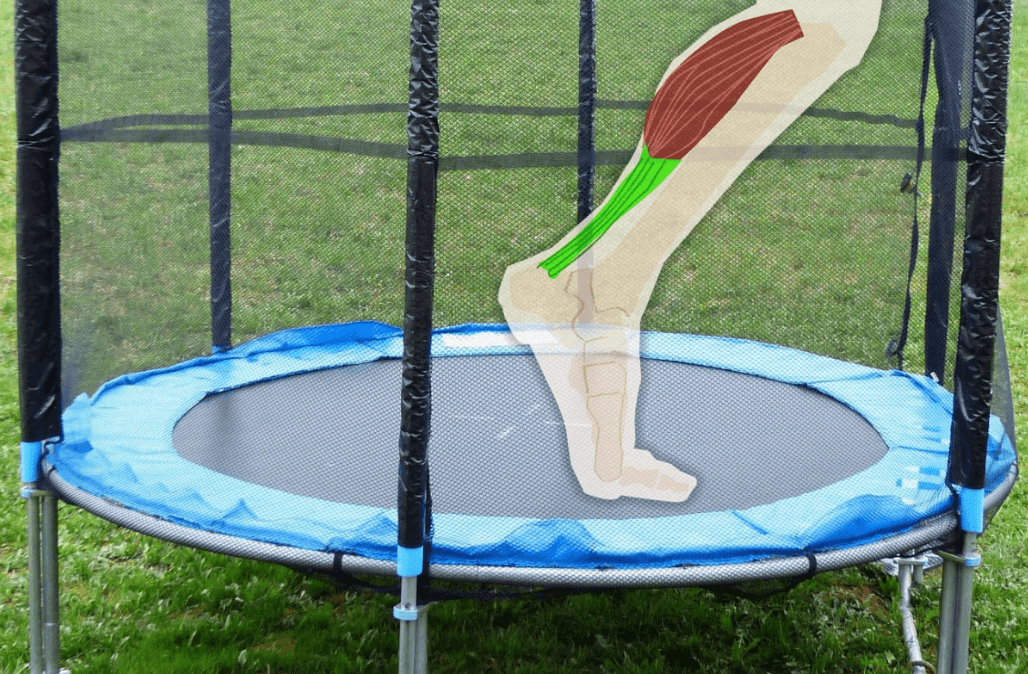
Trampoline exercises engage all the muscles in your legs, starting from your calves and building big quads, hamstrings and glutes.
The calves are engaged while pushing into the floor with both feet to jump higher or slow down momentum when you land. The quads are activated when you bring the knees up towards the chest during the jump or during a turn.
Glutes also receive tons of attention in trampolining thanks to the jumping involved. It strengthens and tones your glutes, making them more firm and toned.
Back & Shoulders

The muscles across your back will fire whenever you do a dismount or dive off the trampoline.
As you brace your core and hinge forward, you engage the trapezius, latissimus dorsi and the deltoids, at the same time.
It also involves your rotator cuff, which are four muscles that are located around the shoulder blade that stabilize the shoulder.
Another exercise I like doing that works the back and shoulders and that is also fun is jumping jacks, doing 100 jumping jacks a day is a lot of fun and since jumping jacks burns calories, you also get to shed off a few pounds while at it. But don't get carried away like I did and start doing 1000 jumping jacks though, it might be tough.
Things to Keep in Mind to Avoid Injury While Jumping on A Big Trampoline

Trampoline injuries are more commonplace in kids than in adults. But that does not mean that you can hop on a big trampoline and go all guns blazing.
There are some basic rules to follow that will minimize the risk of injury, regardless of how experienced you are with trampolines.
Start slow
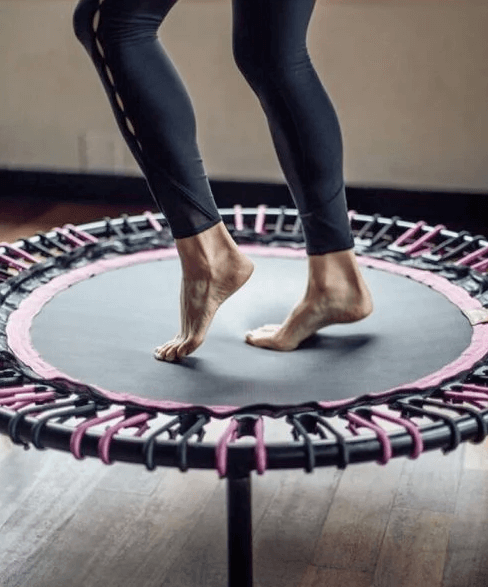
Trampolines are exciting and they produce a sharp adrenaline rush. However, it's important that you take it slow and learn how your body reacts to the trampoline mat and springs.
Only then should you progress to more difficult moves like jump turns and backflips. That too under the supervision of an expert or a coach.
Listen to your body
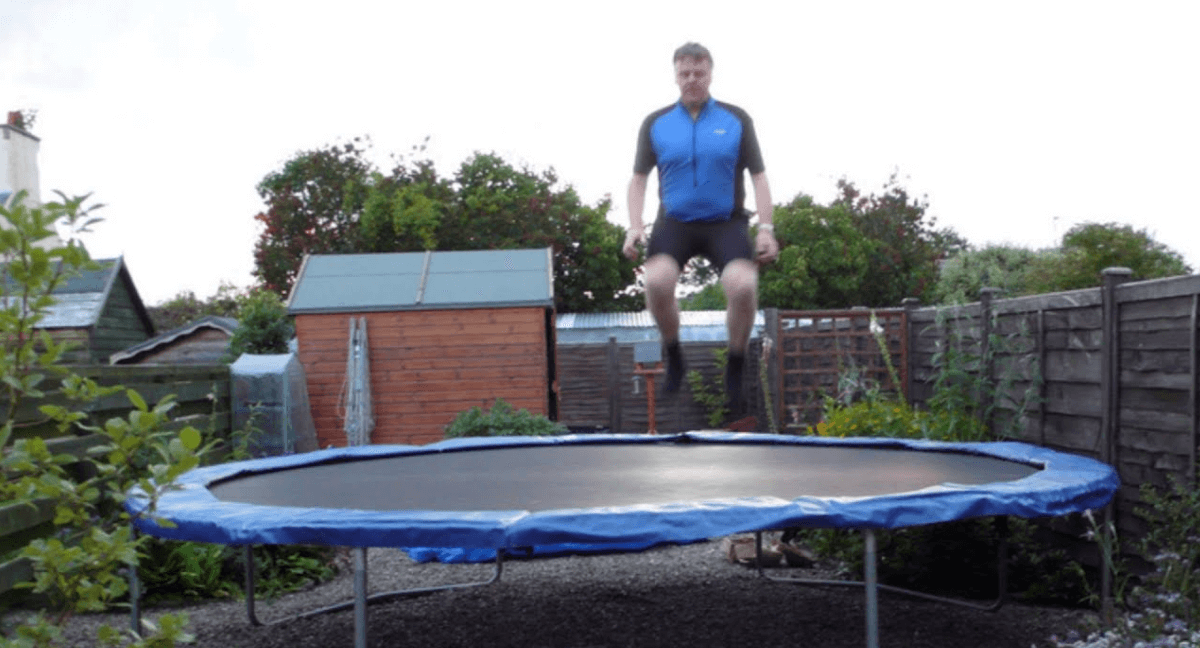
When you are on the trampoline, it's important that you listen to your body and understand what it is communicating to you. This goes beyond just pain related sensations. Your body regulates temperature while you bounce, so overheating is one of the reasons why people end up with dizziness and nausea.
In case you experience dizziness, nausea or any discomfort when you're on the trampoline, stop there and then.
Take a Break Between Workouts

Trampolining can be strenuous. In fact it's one of the most intense cardiovascular exercises. So it's important that you don't push yourself too hard or go overboard with the workouts.
Monitor your heart rate and anytime you feel that you are exerting too much, pause and take a break.
Stretch Before You Start

Stretching increases your flexibility which allows you to spring higher, do more advanced tricks and avoid injury.
A light stretch for about 10 minutes before jumping can be very beneficial - and the benefits of stretching don't just end there, there have been a debate on whether stretching can actually make you taller.
Don't Round Your Back Too Much

One of the biggest dangers and also one of the most easily avoidable mistakes while trampolining is to round your back.
You do not want to bend at your waist while you are on a big trampoline, especially when doing fun flips and tricks. This can lead to severe injury because of all the pressure it puts on your spine.
Instead keep the core engaged and the stomach tight all the time. This will also help you land better, avoid bouncing into another person or object, and reduce the chance of injury from any side. This holds true for other essential fitness exercises too, and more so when doing advanced moves like the planche lean, which require a great deal of concentration.
How Jumping on A Trampoline Improves Your Flexibility

It is estimated that trampoline jumps recruit up to 400 muscles. Not all of them are major muscle groups. There's a lot of stabilizer muscles which work as support systems.
Engaging these muscles regularly, makes them work in synergy which improves your balance, flexibility and overall range of motion.
It's just like how doing 1000 squats a day or lunges can improve your flexibility because it involves an eccentric (downward) movement.
You start off using muscles that are normally under-utilized in daily life but become engaged during the jump.
Pros and Cons of Trampoline Exercise
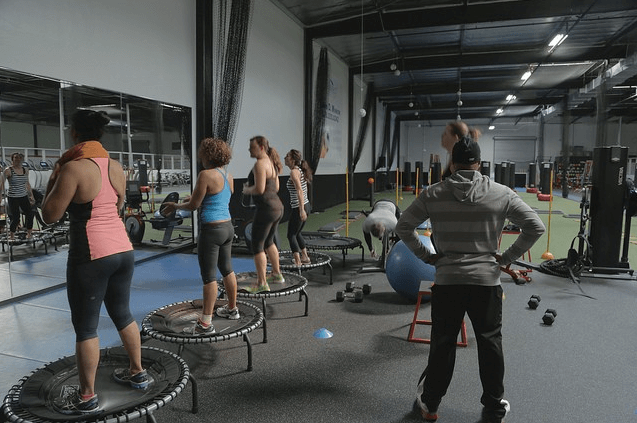
How does the trampoline fare in terms of risk vs. reward? Let’s find out.
Pros
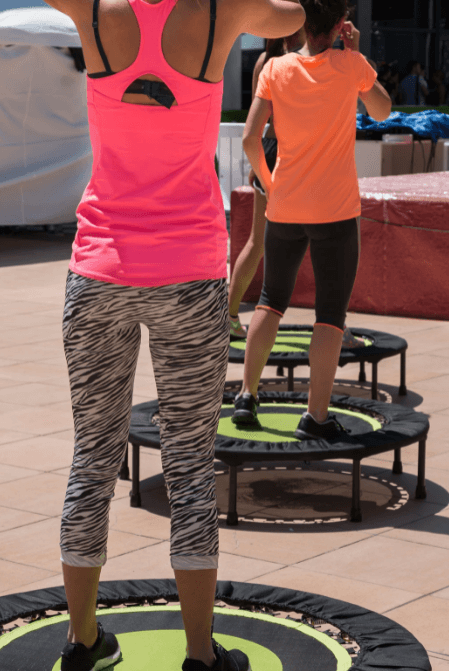
- Trampolines involve a lot of jumping. But they are in fact a low impact exercise because you don’t have to bear the weight as the mat absorbs most of the impact.
- It's a total body workout involving balance, coordination and power. There is more than one study that points to the multiple benefits that trampolining offers.
- It's a great calorie burner. Try trampoline jumps for 20 minutes and you will be left in a pool of sweat and tears.
- It improves balance and stability, which translate into better mobility and functional fitness.
Cons
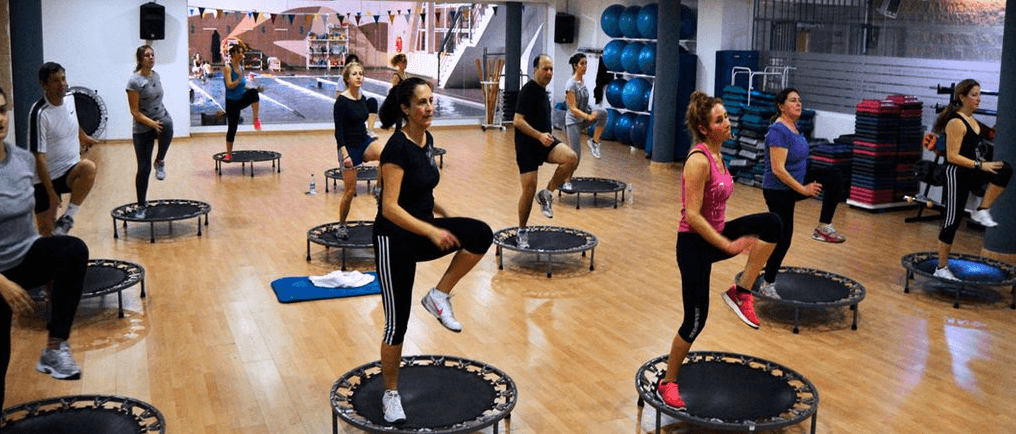
- It has a steep learning curve. While jumping on a trampoline seems like a no-brainer, there is in fact, a technique to it that you have to master.
- Also, injuries are still possible even if proper care is taken. It is one of the most injury prone sports because there aren't many well-trained professionals out there. So you will have to take extra precautions before jumping onto a trampoline for fitness purposes.
- You need access to one. As an adult, you cannot make do with a kiddie trampoline. You'll need a huge one that can sustain your weight and hold up to every day abuse. You either head out to a trampoline park or get one home.
Is Jumping on A Trampoline Better than Running?

I am a staunch believer in doing what works for me. After I busted my knee a few years ago, running has practically flown out of the window.
I look for lower impact cardiovascular exercises and the elliptical cycle and the trampoline have been godsend.
But to call it better than running might be generalizing things a tad. Here's the deal.
If you enjoy running, go out there and run, running can be beneficial for weight loss or weight gain, believe it or not. If you are unable to run due to some reason and can jump on a trampoline instead, you are getting an equally good workout, which might even offer more advantages.
Which is Better: Jumping on a Mini Trampoline or Big Trampoline?
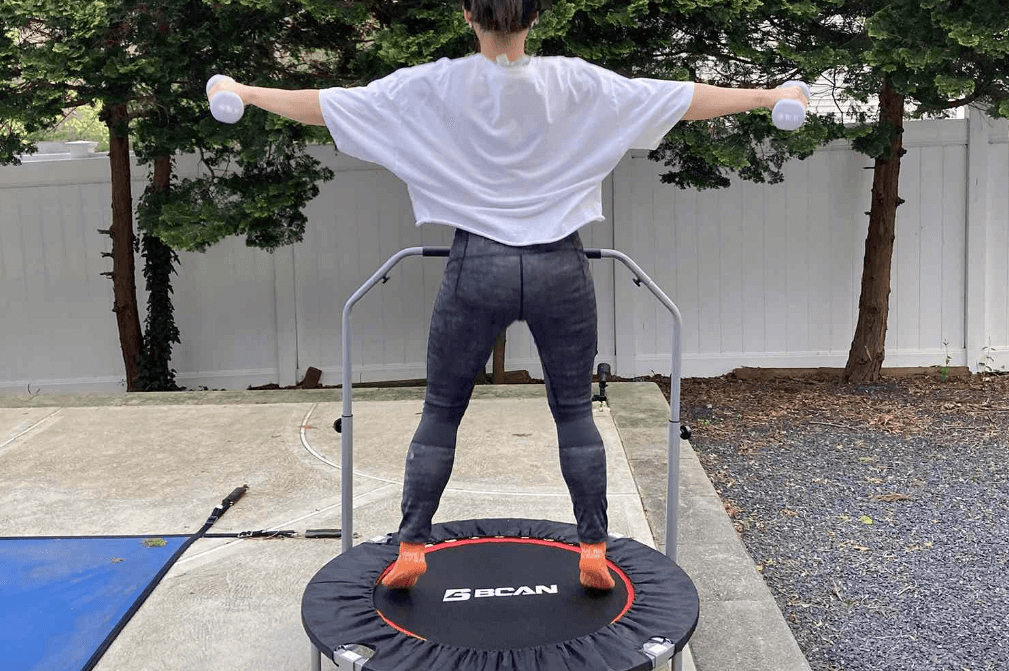

In recent times, the mini trampoline has become a rage. These are the ones that you can fit into small spaces and keep in your garage or backyard to take out whenever you feel like jumping for 5-10 minutes while watching TV or something.
Their small size makes them ideal for interval training, but their max height is somewhere around 4-5 feet, nowhere near what a standard trampoline can offer.
So if you have a big backyard, it's not going to serve your purpose as well as a standard trampoline.
Also, a standard trampoline is always going to be heavier and more stable. The small trampolines can move around a bit on the mat, posing a risk of injury especially if you are jumping with reckless abandon.
In short, it boils down to your requirements. If you need a mini workout device that can go anywhere you want, get a mini trampoline.
FAQS About Jumping on A Big Trampoline
There is still a whole lot more to jumping on a trampoline than all that we have covered thus far.
For those who still feel some questions have remained unanswered, here are a few more tidbits I would like let you in on.
Does jumping on a trampoline burn belly fat?
Burning belly fat or any fat from your body is about calorie expenditure vs. calorie consumption. Jumping on a trampoline can take care of the second bit in that equation. It will produce an intense calorie burn, while revving up your metabolism enough to sustain that burn for up to 48-hours after you stop jumping. If you can eat clean, then yeah. It can burn belly fat.
Is Jumping on A Trampoline High Impact?
No, it isn't. 80% of the force of impact will be absorbed by the mat. But it also depends on how you jump. If you land all your jumps in the center of the trampoline, then it's going to be a low impact exercise. But if you are rigid and jump on the fringes, it can cause injuries, especially to the ankles and knees.
How Much Weight Do You Lose when You Jump on A Trampoline?
Unfortunately, we cannot quantify that. The number of calories you burn while jumping on a trampoline depend on how intense your workout is, which in turn is determined by your weight and how vigorously you are moving around the mat.
How Many Minutes of Jumping on A Trampoline Equals a Mile?
It doesn't equal a mile. It is simply not possible to equate the movement of your legs on a trampoline to that running or walking.
How Many Calories Do You Burn Jumping on A Trampoline for 10 Minutes?
In an ACE sponsored study, men burnt an average of 12.5 calories per minute on the trampoline, while women burnt 9.4. If you multiply that by 10 minutes, it averages to 125 calories which is amazing. But everything, including your weight, age and intensity would have to match the participants in the study. Rather than being hung up over numbers, focus on how intensely and safely you can jump.
Related Readings:
- Should I Train Shoulders After Chest Day?
- Best Incline Treadmills & Trainers – Top Auto Incline Picks for Your Buck
- I Did 100 Pushups 100 Situps 100 Squats for 30 Days – Results and What I Learned
- Foldable Exercise Bike with Comfortable Backrest
- Tips & Strategies I Used to Stop Eating Sugar
- How to Get Abs in 2 Weeks for Guys
Resources:
- https://time.com/4504548/jumping-trampoline-exercise-workout/
- https://acewebcontent.azureedge.net/certifiednews/images/article/pdfs/ACE_MiniTrampoline.pdf?utm_source=Rakuten&utm_medium=10&ranMID=42334&ranEAID=TnL5HPStwNw&ranSiteID=TnL5HPStwNw-4r3U96JoIIMwwrwLotSCTw
- https://journals.physiology.org/doi/abs/10.1152/jappl.1980.49.5.881
- https://livehealthy.chron.com/trampolining-build-muscle-9379.html


